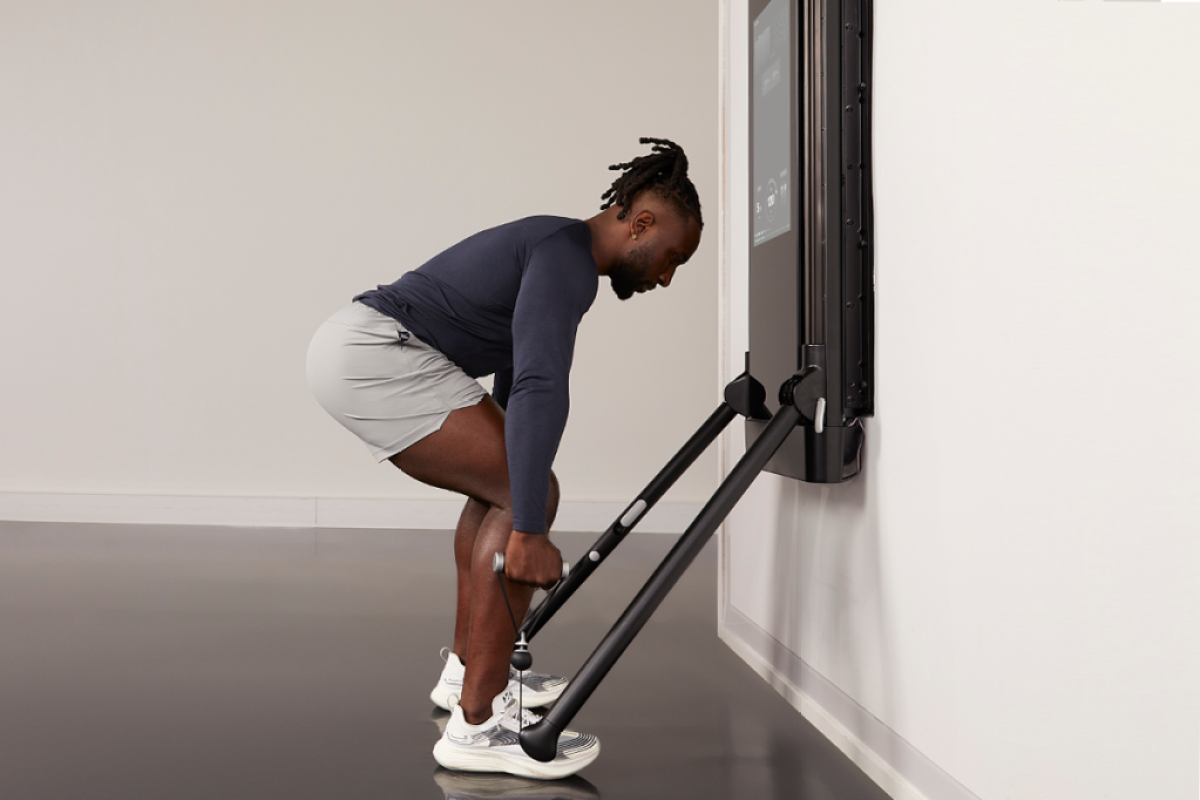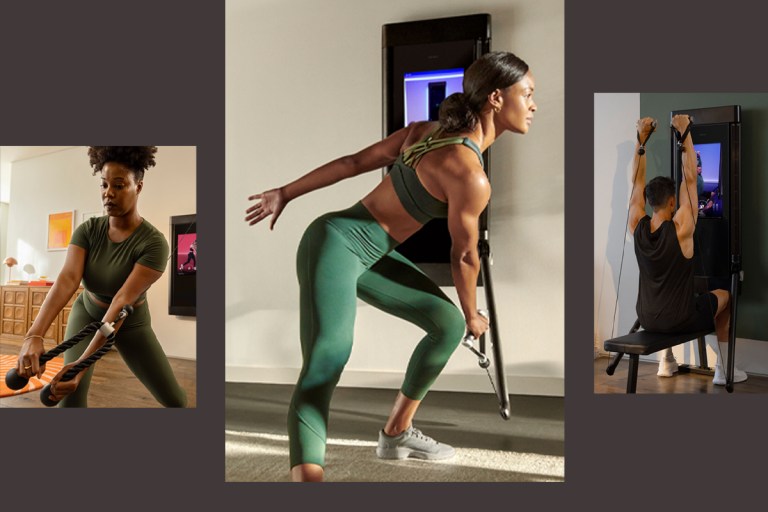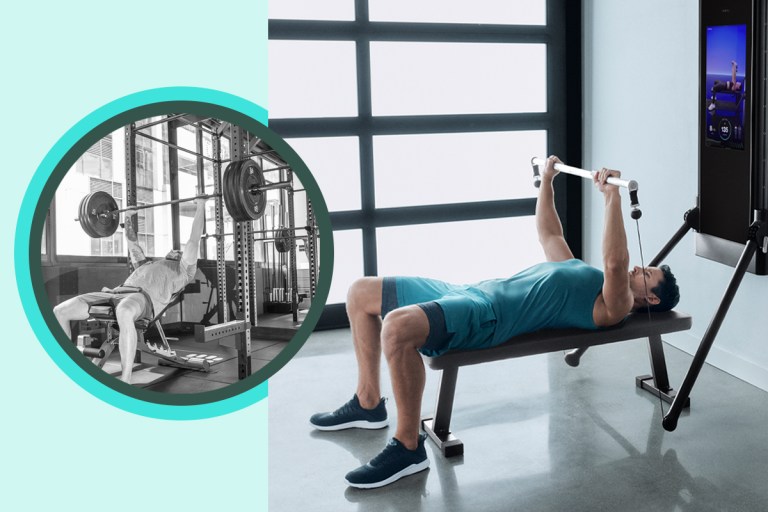More Rest for More Muscle: Cluster Sets Explained
This simple technique can help you keep your form in check and generate more power with every rep.

In fitness, we often celebrate the struggle of making it through a long, tough set. Athletes are encouraged to keep going when they’re flirting with muscular failure, championing a “can’t stop, won’t stop” training philosophy.
In some instances, this relentless pursuit of reps is warranted: It builds muscular endurance and can help experienced lifters push past plateaus. But other times, a little extra recovery is justified. And when rest is intentionally programmed in the middle of a set, as part of a cluster set, it may help you generate more power and perform cleaner, higher-quality reps.
What Are Cluster Sets?
Jacob Rauch, CSCS, PhD candidate, and performance manager of applied training science at Tonal, describes cluster sets as “an alternative set strategy where you include normal inter-set rest periods accompanied by your traditional rest periods between sets.” Essentially, you’re resting between reps, not just sets.
For example, the standard programming for a six-rep max for a deadlift looks something like this:
3 Sets of:
6 reps
2-minute rest
Each set includes six back-to-back reps followed by a two-minute recovery period.
To apply cluster sets to the same workout, you break up each set into “clusters” or mini-sets of two or three reps and take a short break—typically no more than 30 seconds—between each rep cluster.
So, a cluster-set version of the same workout look like this:
3 Sets of:
2 reps
20-second rest
2 reps
20-second rest
2 reps
2-minute rest in between sets
Whether you’re using cluster sets or following a more traditional set and rep scheme, you’re lifting the same load and completing the same amount of work. However, cluster sets afford more frequent rest periods, allowing you to preserve your energy and ultimately perform each rep more effectively, explains Rick Richey, DHSc, MS, faculty for the National Academy of Sports Medicine (NASM).
“The idea is that you’re just trying to avoid reaching fatigue,” he says. “You’re able to lift more explosively without getting to the point where you’re compromising technique as you start to fatigue.” Those extra recovery periods can mean the difference between consistent, high-quality lifts and struggling to finish a set with poor form.
What Are the Benefits of Cluster Sets?
While cluster sets can be tailored to most resistance-training goals, they’re most commonly applied to strength and power workouts, says Rauch. “It’s a style of training that’s more effective for maintaining repetition velocity and power output within a set compared to a traditional set because you’re not going to have as much drop-off or the build-up of fatigue,” he says, noting a 2019 review and meta-analysis published in Sports Medicine. After reviewing data from 25 studies, the authors determined that cluster sets “are a useful strategy to attenuate the loss in velocity, power, and peak force during resistance training and should be used to maintain neuromuscular performance.”
In practice, it makes sense. Think about trudging through a seemingly never-ending set of rotational chop—the last few reps tend to be far less dynamic than the first few. Incorporating small periods of recovery throughout a set can help keep your movements snappy and preserve the original intention of a rotational chop: power development. The same goes for building strength; if you’re so depleted that you can’t properly complete the last few reps of your set, you’re not fully benefiting from it.

Built-in rest periods also allow lifters to focus on their form and, if necessary, make corrections in the next cluster or reps. Rauch explains that as you become fatigued and lose velocity, “you’re going to be moving more slowly through that form, and in moving more slowly, you basically have more time for your form to break down. Injecting those little breaks within the set allows you to reset and gather yourself,” he says.
From a psychological perspective, cluster sets can make a lifting session less daunting and more palatable, especially for beginners. As with any overwhelming task, dividing the work into smaller pieces and taking more frequent breaks makes heavy loads and large volumes feel doable. “The best exercise program is one that you will adhere to and perform,” Rauch says. “So, if splitting up a set makes it more enjoyable or less intimidating, and you’re more likely to come back to it, then that’s just an added benefit.”
How Are Cluster Sets Different from Supersets?
While a cluster-set strategy includes more frequent rest periods, supersets typically increase work volume and density by eliminating rest periods between sets. Often, two separate movements that target different muscles are programmed back to back so that the first muscle group has time to recover while the second muscle group works.
For example, supersetting a squat with an overhead press allows your lower body to rest while your upper body works. You can also superset exercises that engage different muscles within the same region, like the bench press, a chest strengthener, and the bent-over row, which primarily targets the back muscles.
More advanced lifters may choose to superset movements that target the same muscle. “You might do a bench press and then superset that with a dumbbell fly,” Richey says. “And it’s just like, ‘Can I gas out anything left in my pecs?’ That’s the opposite of what the cluster set is. We’re not trying to gas out anything. We’re trying to make sure every single lift has enough rest in between it so we can do a really good lift again in a few seconds.”
What’s An Example of Cluster Sets in a Workout?
There’s no one way to use cluster sets; they can be applied to most movements, and the ideal number of reps, sets, and rest periods depends on the purpose of the workout.
Here are a few examples of how to apply cluster sets to the squat based on your training goals. (Note that the load would also change based on your goal.)
Cluster Squat for Hypertrophy (Muscle Growth)
If muscle growth is your primary goal, you want to lift heavy—about 75 to 85 percent of your one-rep max—and do between six and 12 reps per set. The following programming keeps your total reps high but allows for several brief, interset rest periods.
4 Sets of:
4 reps
20-second rest
4 reps
20-second rest
4 reps
2-minute rest between sets
Cluster Squat for Maximal Strength
When building maximal strength, your load is higher (85 to 100 percent of your one-rep max). Therefore, you perform fewer reps. This workout incorporates a small recovery period after every two reps, potentially allowing you to generate more force with each rep than if you performed six back-to-back reps.
3 Sets of:
2 reps
20-second rest
2 reps
20-second rest
2 reps
2-minute rest between sets
Cluster Squat for Power
When training for power, the focus is on generating high levels of force and velocity. Taking a quick break after every squat ensures that each rep is explosive.
3 Sets of:
1 rep
15-second rest
1 rep
15-second rest
1 rep
15-second rest
1 rep
15-second rest
1 rep
2-minute rest between sets
Cluster Sets on Tonal
See the benefits of cluster sets in action with these coach-led Tonal workouts and programs.
Mini Sets, Major Gains – Multiple Coaches

The workouts in this two-week program utilize cluster sets to help you accumulate lots of muscle-building volume as you maintain your intensity in challenging lifts.
Power Hour 2 – Coach Kendall “Woody” Wood

Cluster sets pop up during burnout blocks in this program’s workouts. You’ll get a chance to rep it out in barbell compound moves with short rests that help you stay strong through the finish line.
Quick Fit: Deadlift Clusters and Thrusters – Coach Tanysha Renee

This power-packed lower-body workout is all about improving your deadlift with low-rep, heavy-weight cluster sets.


